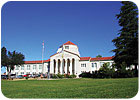
During the 2005-06 heating season, the Learning Center, Enterprise High School, and Shasta High School reduced usage by 73%, 63%, and 49%, respectively, compared to 2001-02 consumption, thanks to extensive HVAC retrofits.
Shasta (CA) Union High School District has undergone a $27 million dollar, district-wide modernization over the past five years. Due to the project’s size, school administrators were not interested in a quick fix. Rather, they were committed to making sure that the improvements produced long-term cost savings and the best learning environment possible. Now that the project is complete, the district is reaping tangible benefits, including energy savings of more than 70%.
The energy savings are a result of vast improvements made to four buildings - Shasta High School, Shasta Learning Center, Enterprise High School, and Foothill High School. More than 600 new windows were installed, many of which replaced the original frames and glass from 1927. Additional savings were realized from the HVAC renovation, which included designing a system consisting of a 200-ton, air cooled chiller for the classrooms and three smaller chillers for the gyms as well as nine AERCO boilers.
A Critical Decision
Engineer Keith Ritter, co-founder of M/E Systems Engineering, was retained by the school district for the renovation. Of all the decisions Ritter had to make, one of the more critical was which boilers to install.“I was looking for units with high turndown because of their long-term savings benefit. I also wanted boilers that could deliver a wide range of non-cycling operation,” said Ritter. The latter feature was important since the school district is located in Redding, a town in the far north of California. Redding typically experiences long but moderate winters of 30°F to 40° and 3,500 heating degree-days each year.
Ritter conducted evaluations of various boilers and decided that the AERCO KC1000 and Benchmark 2.0 boilers were the best choices for the job. Not only are they designed to operate in condensing mode, but the one million Btuh KC1000 units that were installed had 14:1 modulation and could match heating loads as low as 70,000 Btuh before cycling off. Plus, the Benchmark boilers’ 20:1 burner turndown would enable it to match loads between 100,000 and two million Btuh for outstanding seasonal efficiency. At low fire in condensing mode, these units can deliver thermal efficiencies up to 99%. Greg Schnable, senior sales engineer for Clyde Equipment Company, Inc., worked with Ritter and supplied the AERCO boilers.
The success of the renovations is evident by the savings reported by the schools. During the 2005-06 heating season, the Learning Center, Enterprise High School, and Shasta High School reduced usage by 73%, 63%, and 49%, respectively, compared to 2001-02 consumption.
Beyond HVAC
An electrical upgrade was completed within the HVAC project’s scope. The upgrade consisted of new transformers, switchgear, and distribution panels, and has improved service in the classrooms. This upgrade increased the electrical costs, but they have been more than offset by the fuel savings created by the improved HVAC system.Further helping lower fuel costs was the replacement of 630 windows at all the schools. “We still had the original windows and panes that dated back to 1927. Part of the project included replacing those with new, more energy-efficient windows,” said Jack Leclair, director of maintenance and operations at Shasta Union High School District.
In addition to undertaking operational improvements, the renovations improved the aesthetics of the schools. The exterior of the schools were painted and new landscaping was planted. There were other exterior renovations as well, according to Leclair.
“Over the years, the original clay tiles on the roof of Shasta High School had been periodically replaced with different materials, creating an unattractive appearance and leaks. We were able to find the original roof supplier and buy new tiles that have the same style as the original roof. Now it looks much better and prevents water from leaking into classrooms,” explained Leclair.
The Shasta High School auditorium was also given a facelift. All 1,700 seats were removed and shipped to the original manufacturer - still in business after nearly 80 years - for restoration. Also restored were the original ornate plaster work on the interior walls and ceilings to give the hall a truly historic look. When it came to sound and lighting, the renovations took on a modern feel, as they were upgraded to state-of-the-art systems.
Now that the renovations are complete, the school district is receiving energy savings, as well as creating a much better learning environment for students and work environment for teachers.ES
